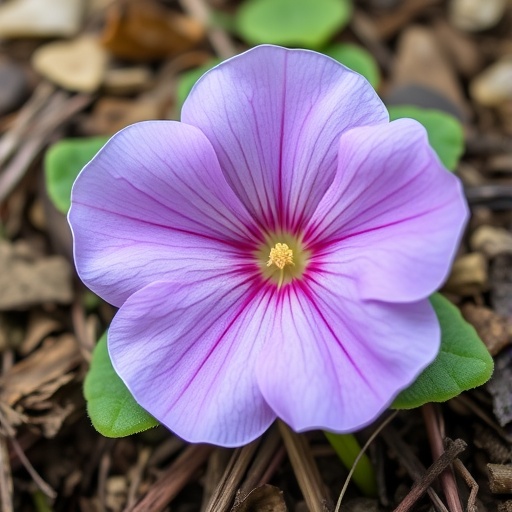In a remarkable stride toward biodiversity understanding, the discovery of Cymbalaria muralis (commonly known as wall pennywort) in the Kashmir Himalaya marks a significant academic achievement, as reported in a recent publication in the journal Discover Plants. This chasmophyte, belonging to the Plantaginaceae family, has been overlooked in this region until now. The research team, led by Khuroo, Zargar, and Sofi, embarked on an expedition that sparked an endeavor not only to document its presence but to delve into its ecological implications and distribution patterns in a region renowned for its unique flora and varied climatic conditions.
The Kashmir region, often enchanting in its scenic beauty, conceals within its slopes numerous plant species that have adapted to the harsh environmental constraints of mountainous terrain. The introduction of Cymbalaria muralis expands the known botanical diversity within this landscape. This discovery comes at a critical time when environmental changes and anthropogenic influences are disrupting habitats across the globe. The researchers meticulously documented the conditions under which this species flourished—an insight valuable for conservation efforts and a clearer understanding of Himalayan biodiversity dynamics.
Cymbalaria muralis is well known for thriving in rocky crevices, where it exhibits a remarkable ability to withstand significant physical stress. Its suction cup-like roots enable it to cling onto sheer surfaces, making it an exemplary chasmophyte. This trait is not only fascinating from a botanical view but showcases remarkable evolutionary adaptations. By forming strong root systems in hostile environments, this species plays a critical role in preventing soil erosion, fostering habitat stability, and facilitating other plants’ growth nearby.
The team’s research delved into the various ecological roles played by Cymbalaria muralis. The presence of such a species in the Kashmir Himalaya may indicate a myriad of underlying environmental factors, including microclimates that favor specific plant communities. The research team also specutlated on potential interactions between Cymbalaria muralis and local fauna, recognizing that plants often have mutualistic relationships with various species—be it through pollination, seed dispersal, or even soil enrichment.
In documenting their findings, the researchers were not merely validating the existence of Cymbalaria muralis; instead, they were elaborating on its contributions to the overall ecosystem. The significance of such research extends beyond academic interest; it touches on the urgent need to prioritize biodiversity in conservation strategies. Similar species, potentially undiscovered, could provide essential ecological functions, influencing everything from local climate regulation to nutrient cycling in the Himalayas.
The challenge of preserving biodiversity in a changing climate cannot be overstated. Particularly in places as environmentally sensitive as the Himalayas, where glacial shrinkage and increased human encroachment loom large, documenting and understanding even the smallest plants can have far-reaching implications. The findings regarding Cymbalaria muralis thus not only showcase the plant’s inherent beauty and resilience but also serve as a clarion call for ongoing research and conservation planning.
In addition to its biological significance, the study of Cymbalaria muralis could inspire further research into the broader family of Plantaginaceae. This entire family presents numerous species that may hold untapped potential in pharmacology, horticulture, or even climate resilience strategies. Thus, by promoting scholarship surrounding Cymbalaria muralis, researchers may further illuminate the vast legacy of the Plantaginaceae, sparking new initiatives aimed at exploring the potential applications of their unique traits.
However, the discovery invites a plethora of questions that extend beyond initial documentation. For instance, what factors are driving the distribution of Cymbalaria muralis in these specific regions? Could genetic variations offer insights into its adaptive strategies? As the research team advocates for ongoing botanic surveys in the Kashmir region, they highlight the importance of a multidisciplinary approach, intertwining ecology, genetics, and climatology, to fully understand the plant’s resilience and role in its ecosystem.
As multiple stakeholders grapple with the implications of climate change and ecological degradation, studies like the one conducted by Khuroo and colleagues serve as a guiding light. The integration of scientific inquiry with local conservation efforts emphasizes the pressing need for collaborative approaches to protect not only local flora but also the intricate web of life it supports. By fostering a deeper understanding of plants such as Cymbalaria muralis, researchers and conservationists can better advocate for policies that protect these biodiverse ecosystems.
In conclusion, the recent discovery of Cymbalaria muralis in the Kashmir Himalaya is more than an isolated finding—it represents a critical juncture in the ongoing narrative of biodiversity conservation in fragile ecosystems. The work of Khuroo, Zargar, and Sofi stands as a reminder of the compelling need for continued research and advocacy in the face of environmental challenges. As scientists push the boundaries of what we know, they not only contribute to the academic realm but also ignite passion and action toward safeguarding our planet’s invaluable natural heritage for future generations.
Emerging from the shadows of obscurity, Cymbalaria muralis now challenges us to rethink our relationship with the natural world and the thin line that separates survival from extinction. The road ahead is not just about documenting rare species but about implementing meaningful strategies that ensure their protection for decades to come.
Subject of Research: Chasmophyte distribution in the Kashmir Himalaya.
Article Title: Chasmophyte Cymbalaria muralis (Plantaginaceae), a new distribution record for Kashmir Himalaya.
Article References:
Khuroo, A.A., Zargar, S.A. & Sofi, S.A. Chasmophyte Cymbalaria muralis (Plantaginaceae), a new distribution record for Kashmir Himalaya. Discov. Plants 2, 290 (2025). https://doi.org/10.1007/s44372-025-00372-4
Image Credits: AI Generated
DOI:
Keywords: Biodiversity, Cymbalaria muralis, Himalayas, Plantaginaceae, Ecology, Conservation, Climate Change.
Tags: adaptation of plants to harsh terrainanthropogenic influences on habitatsbiodiversity dynamics in the Himalayasbiodiversity in Kashmir Himalayachasmophyte distribution patternsCymbalaria muralis discoverydocumenting plant species in Kashmirenvironmental changes in mountainous regionsHimalayan flora conservation effortsPlantaginaceae family plantssignificant academic achievements in botanywall pennywort ecological implications





